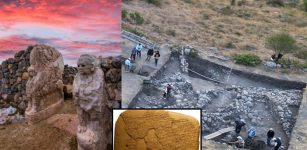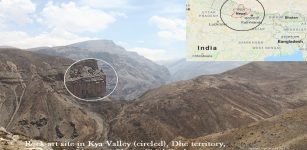Manticore – Legendary Persian Sphinx Whose Existence Is Still Discussed
Ellen Lloyd - AncientPages.com - Whenever the word “sphinx” is mentioned people automatically think about the Great Sphinx of Giza. It’s not surprising because it is today the most famous and admired sphinx of the ancient world. However, we shouldn’t forget there were other, very similar creatures that are today mostly forgotten.
One of them was the Manticore, the legendary sphinx of Persia.
Manticore in an illustration from the Rochester Bestiary (c.1230-1240). Credit: Public Domain
The Manticore was discussed by several ancient Greek authors, and this mysterious being has been depicted in western European Medieval art.
The Persian myth about the Manticore whose name means "man-eater" is very old. The Manticore was a bizarre creature that was said to have the body of a lion, the head of a man, bat wings, and the spiked tail of a scorpion. This combination made the Manticore extremely dangerous and the creature preyed not only on animals but also on humans.
“Originating in Persian mythology (modern Iraq) and documented by Greek naturalists, the manticore is described as having a keen appetite for humans and a howl like that of a trumpet.
The manticore’s morphology no doubt evolved out of necessity from the rugged terrain it occupied in Persia and the Middle East. It needed as many weapons as possible to both hunt a scarce food source and defend itself against predators. Preying on animals such as mountain goats and pigs, the manticore would find itself in human villages lured by the livestock. It is thought that the manticore began to feed on humans, developing a taste for such meat, thus establishing the lore of the man-eating manticore,” William O'Connor explains in Dracopedia The Bestiary.1
“The Manticore should not be confused with the Mantiger (or Mantyger) popular in medieval bestiaries, which had the body of a tiger, the head of a man and the feet of a monkey.”2
When Greek historians became interested in the Manticore, knowledge about this peculiar creature spread across Europe.
Manticore or mantyger badge of William, Lord Hastings, c.1470. Credit: Public Domain
Some, like for example Pausanias (110 – 180), a Greek traveler and geographer who lived during the reign of Roman Emperors Hadrian, Antoninus Pius, and Marcus Aurelius said he had seen many strange creatures in Rome, and among them was the Manticore.
“The beast described by Ctesias in his Indian history, which he says is called martichoras by the Indians and "man-eater" [androphagos] by the Greeks, I am inclined to think is the tiger. But that it has three rows of teeth along each jaw and spikes at the tip of its tail with which it defends itself at close quarters, while it hurls them like an archer's arrows at more distant enemies; all this is, I think, a false story that the Indians passed on from one to another owing to their excessive dread of the beast,” Pausanias wrote in Description of Greece.
Greek philosopher Apollonius of Tyana, (15 AD. - 100 AD.) was also interested in the Manticore and wanted to learn more about this magnificent but unusual animal.
According to Flavius Philostratus (c. 170–247), “Apollonius asked the question, whether there was there an animal called the man-eater (martichoras); and Iarchas replied: "And what have you heard about the make of this animal? For it is probable that there is some account given of its shape."
"There are," replied Apollonius, "tall stories current which I cannot believe; for they say that the creature has four feet, and that his head resembles that of a man, but that in size it is comparable to a lion; while the tail of this animal puts out hairs a cubit long and sharp as thorns, which it shoots like arrows at those who hunt it.” 3
It was through Pliny the Elder’s book Naturalis Historia the Manticore became famous in Medieval Europe. Descriptions and depictions of the Manticore varied and there was plenty of confusion about the nature and origin of this strange animal. In Inferno, part one of Dante Alighieri’s Divine Comedy, the mythical creature Geryon was depicted as a Manticore.
Woodcut from Edward Topsell's The Historie of Four-Footed Beasts (1607)
Today there is still a dispute about the existence of the Manticore. Some think it’s an extinct species, while others suggest the animal is an unknown type of tiger. One possibility is also that the Manticore could have been some sort of a Chimera, a monstrous Greek creature that was composed of several different animals.
Whatever the truth may be, the fact remains that the Manticore can still be encountered in more modern literature. For example, readers of George R.R. Martin's A Song of Ice and Fire books will remember how the author mentioned that Manticore venom is a very toxic poison.
Written by Ellen Lloyd – AncientPages.com
Copyright © AncientPages.com All rights reserved. This material may not be published, broadcast, rewritten or redistributed in whole or part without the express written permission of AncientPages.com
Expand for references- William O'Connor - Dracopedia The Bestiary: An Artist's Guide to Creating Mythical Creatures
- Jack Goldstein - 101 Amazing Mythical Beasts
- Flavius Philostratus, The Life of Apollonius of Tyana, translated by F. C. Conybeare, volume I, book III. Chapter XLV, pp. 327–329.
More From Ancient Pages
-
 Secrets Behind 2,000-Year-Old Roman Water Management Revealed
Ancient Technology | Aug 4, 2023
Secrets Behind 2,000-Year-Old Roman Water Management Revealed
Ancient Technology | Aug 4, 2023 -
 Old Bone Links Lost American Parrot To Ancient Indigenous Bird Trade
Archaeology | Nov 8, 2022
Old Bone Links Lost American Parrot To Ancient Indigenous Bird Trade
Archaeology | Nov 8, 2022 -
 2,000-Year-Old Rock Art Sites Discovered In Jalapão, Brazil
Archaeology | Mar 11, 2024
2,000-Year-Old Rock Art Sites Discovered In Jalapão, Brazil
Archaeology | Mar 11, 2024 -
 Researchers Find Oldest Evidence Of Human-Caused Lead Contamination In Aegean Region
Archaeology | Feb 4, 2025
Researchers Find Oldest Evidence Of Human-Caused Lead Contamination In Aegean Region
Archaeology | Feb 4, 2025 -
 On This Day In History: Army Of Tsar Alexander I Of Russia Enters Paris – On March 31, 1814
News | Mar 31, 2016
On This Day In History: Army Of Tsar Alexander I Of Russia Enters Paris – On March 31, 1814
News | Mar 31, 2016 -
 Krakatoa Prophecy – Samson’s Mysterious Dream
Featured Stories | Aug 6, 2019
Krakatoa Prophecy – Samson’s Mysterious Dream
Featured Stories | Aug 6, 2019 -
 X-Ray Reveal Ghostly Portrait Of Mary Queen Of Scots Hidden Underneath 16th Century Painting
Archaeology | Nov 3, 2017
X-Ray Reveal Ghostly Portrait Of Mary Queen Of Scots Hidden Underneath 16th Century Painting
Archaeology | Nov 3, 2017 -
 Elysian Fields: Mysterious Resting Place For Heroic And Virtuous Souls In Greek Ancient Beliefs
Featured Stories | Feb 20, 2020
Elysian Fields: Mysterious Resting Place For Heroic And Virtuous Souls In Greek Ancient Beliefs
Featured Stories | Feb 20, 2020 -
 Puzzling Comb Drawing In Huenul Cave May Be The Oldest Rock Art In South America
Archaeology | Feb 15, 2024
Puzzling Comb Drawing In Huenul Cave May Be The Oldest Rock Art In South America
Archaeology | Feb 15, 2024 -
 Mini-Pyramid Discovered In South Saqqara, Egypt
Archaeology | Oct 13, 2017
Mini-Pyramid Discovered In South Saqqara, Egypt
Archaeology | Oct 13, 2017 -
 Cuneiform Tablet With New Indo-European Language Discovered In The Capital Of The Hittites
Archaeology | Sep 21, 2023
Cuneiform Tablet With New Indo-European Language Discovered In The Capital Of The Hittites
Archaeology | Sep 21, 2023 -
 Beautiful Ancient Egyptian Jewelry From The 26th Dynasty Unearthed At Karnak Temples
Artifacts | Mar 3, 2025
Beautiful Ancient Egyptian Jewelry From The 26th Dynasty Unearthed At Karnak Temples
Artifacts | Mar 3, 2025 -
 Mysterious And Sacred Intihuatana Stone Of The Inca Was More Than Just An Astronomy Calendar
Archaeoastronomy | May 8, 2018
Mysterious And Sacred Intihuatana Stone Of The Inca Was More Than Just An Astronomy Calendar
Archaeoastronomy | May 8, 2018 -
 Mystery Of The Strange Rock In New England That People Fear To Approach
Featured Stories | Apr 17, 2024
Mystery Of The Strange Rock In New England That People Fear To Approach
Featured Stories | Apr 17, 2024 -
 Ancient Egyptians Had A Different Definition Of ‘Foreigners’
Ancient History Facts | Apr 14, 2018
Ancient Egyptians Had A Different Definition Of ‘Foreigners’
Ancient History Facts | Apr 14, 2018 -
 Obscure History Of Upper Mustang: Prehistoric Paintings Discovered In Nepal
Archaeology | Dec 21, 2017
Obscure History Of Upper Mustang: Prehistoric Paintings Discovered In Nepal
Archaeology | Dec 21, 2017 -
 Was The Mysterious Powerful Viking Warrior Buried In A Ship In Scottish Highlands A Woman?
Archaeology | Feb 12, 2017
Was The Mysterious Powerful Viking Warrior Buried In A Ship In Scottish Highlands A Woman?
Archaeology | Feb 12, 2017 -
 Vikings’ Encounters With Peculiar White-Dressed Humanoids And Cave Dwellers In Unknown Lands Described In Norse Sagas
Featured Stories | Sep 5, 2024
Vikings’ Encounters With Peculiar White-Dressed Humanoids And Cave Dwellers In Unknown Lands Described In Norse Sagas
Featured Stories | Sep 5, 2024 -
 Anglo-Saxon Kings Were Mostly Vegetarians Before Vikings Settled In England
Archaeology | Apr 21, 2022
Anglo-Saxon Kings Were Mostly Vegetarians Before Vikings Settled In England
Archaeology | Apr 21, 2022 -
 Mystery Of Count St. Germain – He Claimed To Have Lived For Several Centuries
Ancient Mysteries | Sep 4, 2014
Mystery Of Count St. Germain – He Claimed To Have Lived For Several Centuries
Ancient Mysteries | Sep 4, 2014



